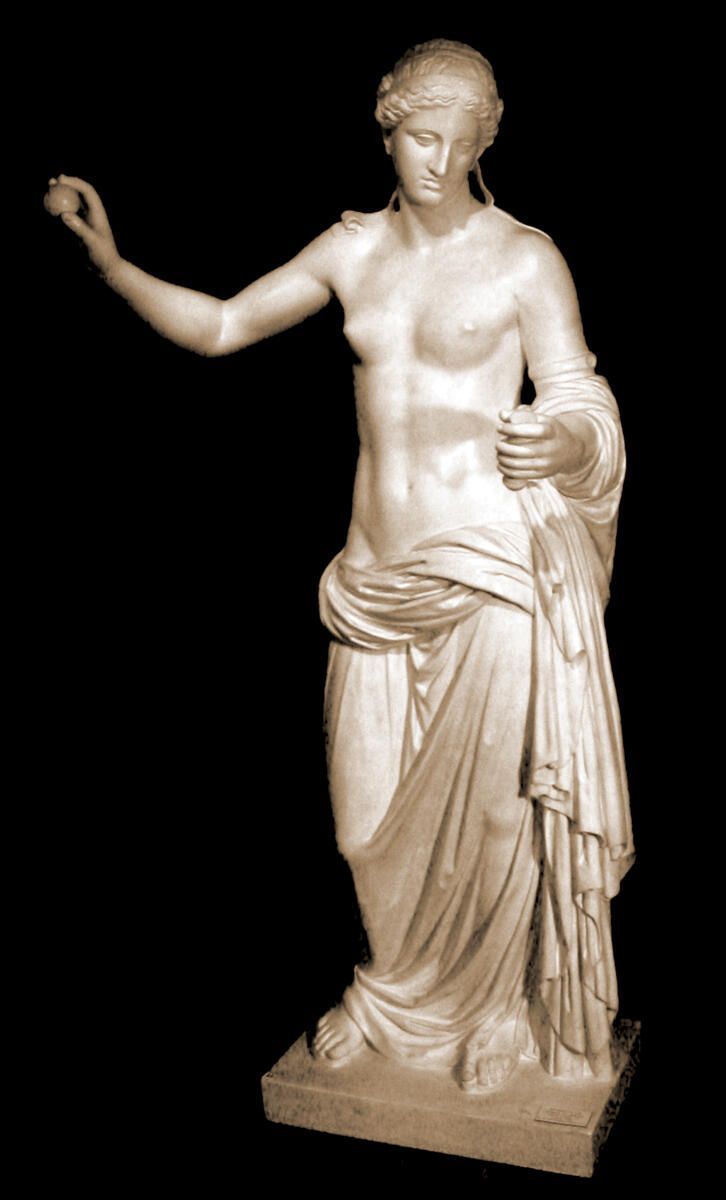Aphrodite of Arles
Name/Title
Aphrodite of ArlesEntry/Object ID
85G0346Description
Statue of the goddess Aphrodite standing in a slight contrapposto pose, head turned slightly to left and looking down into a mirror (now missing except for the handle) she holds in her left hand. Her right hand and arm are raised to shoulder height, and she holds a ball (the Apple of Discord) in her right hand. She wears a diadem atop her forehead and a ribbon binds her hair into a loose chignon at the back of her head. She wears an arm bracelet on her left arm. She is nude except for the drapery around her left elbow, which extends around her hips and down her legs. Plaster copy of marble original.Type of Sculpture
StatueArtwork Details
Medium
MarbleSubject Person
AphroditeContext
Hellenistic copy of a prototype attributed to Praxiteles. Found in 1651 CE at the Roman theater of Arles, France. Mirror into which Aphrodite gazed is now missing. The mirror and the apple (represented by the round object in her right hand) are attributes of Aphrodite. Restored by Francois Girardon in the 17th century CE. With a trance of sagely self-reflection connoting both vanity and vigilance, the Aphrodite of Arles is a Hellenistic tribute to an infamous story in which the goddess herself was an instrumental figure. With an apple in her left hand and mirror in her right, the statue is regal and reminiscent of Aphrodite as she appeared before Paris in the Judgment of Paris to assert her place as the “fairest” among goddesses. In the classic tale, which is a forerunner to the Trojan War, the wedding banquet of the goddess Thetis and the mortal hero Peleus saw all of the gods and goddesses of Olympus in attendance except for Eris, the goddess of Strife. In recompense for not being invited, Eris flung a golden apple the “Apple of Discord” with a signature reading “for the fairest” among the goddesses and left them to their floundering devices. Symbolically the statue retains its significance as an illustration of the infamous war that resulted from Paris’ passionate decision. Making irrefutable the fact that Aphrodite’s influence and tact in drawing a desirable verdict from the mortal solidified her status as the supreme goddess of beauty and sensuality. Physically, the statue harkens back to the most famous of Praxiteles’ works, the Aphrodite of Cnidus. The head of the statue is of Praxitelean origins and serves as a young and rare prelude to the fully nude statue the sculptor would come to garner fame for. After Girardon completed his restoration of the Aphrodite of Arles in an attempt to make it more noticeably Venus-like; with the mirror, apple, and the feminizing of her figure. The resulting statue became a fusion of his transformative skills with Greco-Roman ideals, and gave the Aphrodite of Arles a contemporary cultural significance while promoting its valuable ancient origins.Collection
Classical GreeceMade/Created
Artist Information
Artist
PraxitelesRole
SculptorDate made
399 BCE - 300 BCETime Period
ClassicalEthnography
Culture/Tribe
Greek - Classical

